👋 Ciao, I'm Giulia Blocal, your street art insider. This is Beyond the Walls, a monthly deep dive into street art, graffiti, off-the-beaten-path travel, and a bit of my life in between.
This month, we’re exploring the intersection of street art, intellectual property, and commercialization with insights from my conversation with street artist Ernest Zacharevic, who is making headlines for taking legal action against a corporation that used his work without consent.
But first, a few updates on my life and the BLocal project.
Let’s jump in!
Ciao,
how are you?
I don’t know about you, but January has flown by for me. Between the first draft of my book on London’s street art and organizing the upcoming spring street art trips (Naples, Paris, Lisbon), I’ve barely had time to update the blog (yet below you’ll find three new articles and one refreshed piece 😅), and I’ve completely neglected Instagram—I’ve been fed up with it for a long time, but now that more and more people are stepping away from the platform, I’m taking the opportunity to do the same.
Taking a break from the pressure to always have something to share has also led me to reconsider my relationship with my phone. In this spirit, I’ve been experimenting with a personal detox routine—blocking apps on my phone from 9 PM to 9 AM—and I can’t tell you how much better I feel!
Evenings are now for reading, yoga, and making collages, while mornings start with a slow breakfast, writing my morning pages, and easing into the day without immediately tending to notifications or messages.
What surprised me the most was realizing how often I used to reach for my phone even while doing something else—scrolling, texting, or googling random things while watching a movie had become an unconscious habit. But with this approach, there are no more while-s. I do one thing at a time, fully present, and it’s incredibly freeing.
Another epiphany, disguised as a late New Year’s resolution, hit me halfway through January: stop saving things for ‘special occasions’ and start enjoying them now. No more hoarding the prettiest notebooks on the shelf, waiting for the ‘right moment’ to use them. Life is happening now, and it deserves to be lived fully.
This realization came to me as I rediscovered a box I had long forgotten in my grandma’s attic.
For over 25 years, I’ve called this collection my Corredo—the traditional trousseau Italian women received when they got married, usually with embroidered linens, porcelain, and fine tableware. Mine, however, was a modern twist: a Keith Haring collection of espresso cups, plates, glasses, and more.
This collection was released in the early 2000s, and for over a year, I meticulously bought each piece at the newsstand (they were sold alongside a weekly magazine). I treated it with the same care older generations devoted to embroidering their corredo linens. Naturally, I considered these items far too precious to actually use, so I packed them up and tucked them away in my grandma’s attic—and promptly forgot about them.
Now, as we’re emptying out my grandma’s house (😓), I’ve rediscovered the box with my Corredo. And while I’m not getting married anytime soon (or ever, let’s be honest), I’ve decided it’s time to bring it home and actually use it. Because what’s the point of saving things for a ‘special occasion’ if every day is an occasion?
Sure, a cup or two might break, and a plate might get chipped—it’s inevitable. But at least they’ll be part of my daily life, not just a memory in a dusty box. Every espresso, every meal, will be a little celebration. A reminder that life isn’t meant to be postponed.
So, here’s to sipping coffee from my Keith Haring cups and using the “good” plates just because it’s Tuesday, to stop waiting for the perfect moment and start making the everyday special.
Until next month,
Giulia
ps. Blind Walls Film Fest returns from 5 to 9 February 2025, and I’m thrilled to announce that I’ll be back in Breda 🇳🇱 to host the Friday night of the festival. Mark your calendars, and I’ll see you there!
📚 Updates on my book As Seen on the Streets of Paris
This month, I’d love to share some of the amazing photos you’ve been sending me—thank you so much! ❤️
Keep them coming! I’d love to turn this into a regular part of the newsletter as a way to thank you all for your support. 🫶
This month, I also had a wonderful conversation with Stephanie O’Brien, the host of my favorite street art podcast. While the chat wasn’t specifically focused on the book, we delved into the broader BLocal philosophy that led to its creation.
✈️ Join Me on a Street Art Trip!
March 7 - 9: Experience the Street Art and Culture of Naples!
Although I was born and raised in Rome, Naples has always been my favorite city in Italy. With its rugged charm, incredible food, and rich cultural heritage, Naples never ceases to captivate. Beyond its vibrant energy, the city boasts a pioneering legacy in street art that has shaped its identity as a hub of urban creativity.
In the 1970s, Felice Pignataro’s political murals gave voice to powerful stories on Naples’ walls. By the 1980s, artists like Ernest Pignon-Ernest and Blek Le Rat left their mark, and in the 2000s, Banksy debuted his first Italian works here, cementing Naples as a street art landmark.
During this three-day journey, we’ll explore Naples’ evocative alleys, uncover its breathtaking urban art and hidden treasures, and savor the city’s world-famous cuisine every step of the way.
✨ Early Bird Offer: Book before February 5th to secure your spot at a discounted rate!
Next trips:
🇫🇷 Paris: April 25 – 29
🇵🇹 Lisbon: May 8 – 12
Street Art, Intellectual Property and Commercialization
You might have seen on Instagram the campaign launched by street artist Ernest Zacharevic against AirAsia for featuring his iconic Kids on Bicycle mural on their airplanes without his consent.
When I saw this announcement, I reached out to Ernest—whom I met many years ago—to learn more about the legal action he’s taking and hear his perspective on the broader implications of this issue.
In fact, this incident is not an isolated one. It reflects a larger, ongoing issue where street artists must navigate the exploitation of their creations for commercial gain without proper credit, consent, or compensation.
Beyond this specific case, it raises deeper questions about the commodification of art, the legal gray areas surrounding street art, and the complex interplay of intellectual property and commercialization.
The Corporate Exploitation of Street Art
Created in 2012 as part of the George Town Festival, alongside six other works, Ernest Zacharevic’s Kids on Bicycle mural has become a beloved cultural emblem of Penang, inseparably linked to the city’s identity and vibrant tourism scene. My first question for Ernest was how it feels to see tourists queuing up to capture photos with his creation.
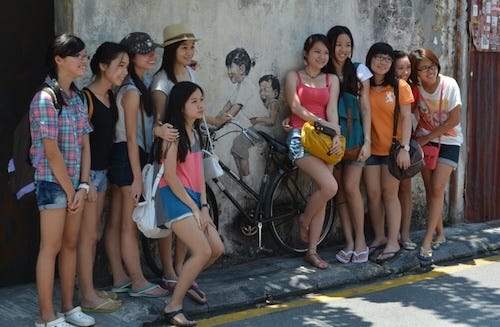
I tend to move on from my paintings once I complete them. Sometimes they require my attention, but it’s nice to let them live their own life. My opinions about my work evolve over time, but the pieces themselves often take on a life of their own and remain part of public consciousness far beyond my involvement.
Ernest Zacharevic
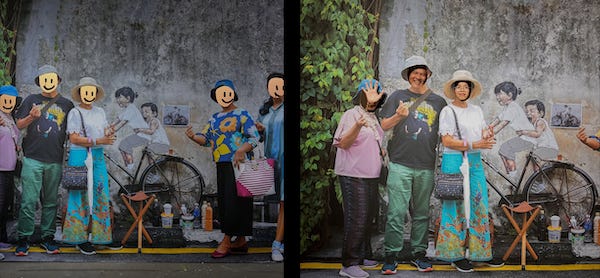
Yet, AirAsia’s unauthorized use of this artwork highlights a power imbalance where corporations extract value from an artist's labor and cultural contributions while disregarding their intellectual and moral rights.
In 2013, I received a promotional email as part of a marketing email blast from AirAsia featuring my artwork as the centerpiece. I immediately contacted them, asking them to discontinue the campaign and seeking clarification. However, I was informed that the campaign had already been approved and was beyond my control to stop. The most frustrating part was witnessing this behavior repeated, even after I made an effort to communicate with them and express my concerns. It highlighted a lack of respect for artists and their intellectual property.
Ernest Zacharevic
Moral Rights and the Artist’s Reputation
The unauthorized use of an artist’s work infringes on their moral rights, particularly the fundamental right of attribution. Without proper credit or consent, artists lose control over how their work is presented and interpreted, which can damage their reputation and distort the original meaning of their creation.
The right of attribution is paramount. In fact, when I asked Ernest what the proper approach from AirAsia—or any company—would have been to handle this situation, he said:
At the time, a simple apology and proper credit would have gone a long way in acknowledging the value of my work. It could have even opened the door to a meaningful and creative collaboration, benefiting both parties.
Ernest Zacharevic
The Legal Gray Area of Street Art
Street art often exists in a fragile legal gray area. Created in public spaces—often without formal authorization—it blurs the boundaries between private property, public accessibility, and ownership.
This ambiguity is frequently exploited by corporations and advertisers, who use the public nature of street art as a convenient justification for unauthorized commercial use, disregarding the rights and efforts of the artists behind these works.
As Ernest points out, this behavior is just one of the many sly tactics corporations use to sidestep accountability—a calculated way of operating that prioritizes profit over ethical practices. When I asked him about the systemic issues within the industry that make such exploitation possible, he shared:
Likely the need to push out campaigns and meet their KPIs, and lack of proper processes to stop, question, and check. “Do first, deal with it later” kind of thinking. When problems do arise, large corporations have management and legal departments. For them, it’s just another part of the job to engage in negotiations and disputes; but for artists, it can be a huge drain on time and resources—time that could be better spent creating art and contributing to culture. The imbalance in resources often discourages artists from pursuing justice.
Ernest Zacharevic
Cultural Appropriation of Street Art
Beyond the legal implications, unauthorized commercialization of street art raises questions of cultural appropriation. Works like Ernest Zacharevic's mural are not only artistic expressions but also cultural artifacts tied to specific communities and contexts. When corporations repurpose such works for profit, they strip them of their original meaning and devalue their cultural significance.
Seeing your work misused can be disheartening, but it’s crucial to stay focused on creating and growing. With persistence and dedication, [emerging artists] can build a body of work that speaks for itself and eventually overcome such challenges. Collaborating with agencies or legal experts can also help protect your rights as you progress in your career.
Ernest Zacharevic
The Larger Issue: Commodification vs. Authenticity
Street art, by its very nature, often critiques consumerism, capitalism, and the commodification of public spaces. Its visual appeal, however, has made it a prime target for branding and marketing, turning once-subversive works into commercial tools. This commodification risks reducing street art to mere aesthetic value, erasing its cultural and social critique.
Furthermore, these cases underscore the imbalance of power between individual artists and corporations. Companies have vast legal and financial resources to prolong disputes, leaving artists with little choice but to accept inadequate compensation or abandon their claims altogether.
This experience taught me how resource-intensive legal disputes can be, particularly for emerging artists. It underscored the importance of focusing on my creative process and seeking professional guidance for future challenges. Navigating the legal world as an artist is extremely complicated. Intellectual property disputes can feel like an uphill battle, full of intimidation and unnecessary roadblocks. It’s vital to seek legal advice early on and to have systems in place to protect your work. At the same time, I believe in focusing on constructive dialogue and systemic changes to support artists’ rights and create a more equitable industry.
Ernest Zacharevic
Ernest Zacharevic’s campaign against AirAsia is not just about his mural—it’s a call to action for the entire artistic community. It highlights the broader vulnerabilities of street artists in a world where public art is increasingly commercialized and commodified.
I’ve learned that many artists face similar challenges, and it’s disappointing how common this behavior is among corporations. There must be tighter laws and regulations around intellectual property rights, especially in visual arts. While industries like music, film, and architecture have agencies and institutions to protect creators, visual artists are often left to fend for themselves. That needs to change.
Ernest Zacharevic
By addressing these challenges and advocating for stronger protections, we can ensure that street art continues to thrive as a medium of cultural expression and public dialogue, rather than becoming another resource for unchecked corporate exploitation.
✍️ New on the Blog!
All About Jorit’s Murals in Naples: Locations and Stories Behind the Art.
Among the most recognized names in street art, Jorit stands out for his breathtakingly realistic portraits that not only captivate with their aesthetic beauty but also deliver profound social and political messages. Born in Naples, Jorit has transcended the boundaries of street art, merging it seamlessly with fine art techniques and activism.
For me, street art is just the medium. I’ve never painted a mural for the sake of it. The point isn’t painting, the point is to share a message that I believe is important to tell.
Jorit Agoch
Co-working spaces and laptop-friendly cafes with Wi-Fi in London.
Forget the noisy Starbucks—London is full of inspiring places to work, far beyond the usual café setup. This selection, curated by yours truly, highlights the best laptop-friendly cafés, co-working spots, and alternative workspaces, all offering free Wi-Fi, plenty of power sockets, welcoming staff, and an ambiance that actually helps you focus.
And because working from cafés—even the quieter ones—has become trickier over the years (is it just me, or does the level of tolerance start running low after 40?), I’ve also included quieter spots such as libraries, bookshops, and versatile venues.
See You at Blind Walls Film Fest 2025!
This Dutch film festival introduces audiences to the intricate world behind graffiti, street art, and murals through an unconventional and captivating medium – cinema.
This unique feature sets the festival apart and makes it a personal favorite -and so I’m happy to announce that next week I’m back in Breda to attend the festival and host the Friday night (February 7th). See you there!
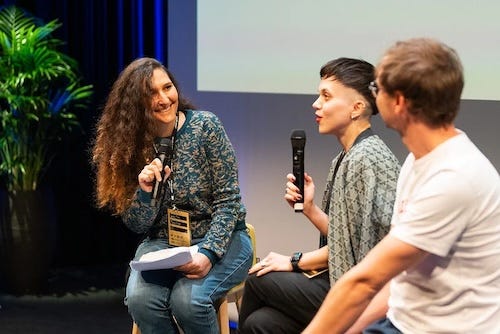
🔄 Updated!
Street Art in Ponticelli, the Neglected Outskirts of Naples.
As I gear up for our upcoming trip to Naples, I took the opportunity to update my article about Parco dei Murales—a true muralism project located in the eastern outskirts of the city.
What I liked about this project is that murals aren’t large-scale reproductions of top-down sketches drawn elsewhere. Street art in Ponticelli isn’t out of context, even if only one of the artists was born in the area. All the artists who took part in this project accepted the challenge of developing their murals in-progress, by listening to the local community, finding inputs in it and opening up to a discussion about their work.
👇 The most clicked link last month 👇
BLU's new animated mural in Naples (fingers crossed it’s still there when we visit)
I rely on the support of readers like you to keep creating genuine and informative content. If you value my work and would like to see more of it, please consider making a donation to support my writing and my editorial project BLocal.
You can Buy me Pizzas, Donate via Paypal, or become a Paid Subscriber.
You can also buy my book, As Seen on the Street of Paris, “like” my post by tapping the ❤️, share them on Substack Notes or other social media, and forward this email to anyone you like.





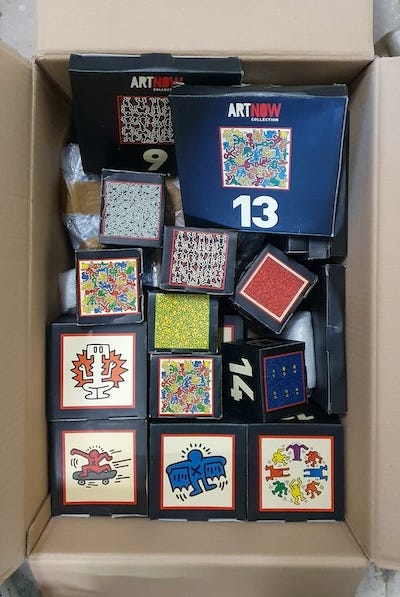
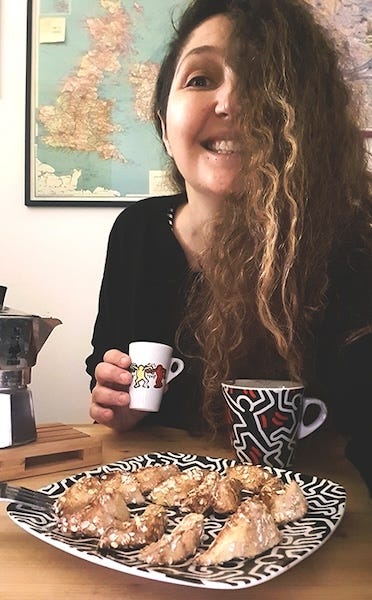
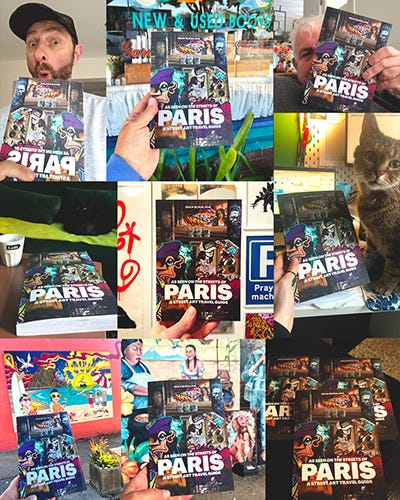

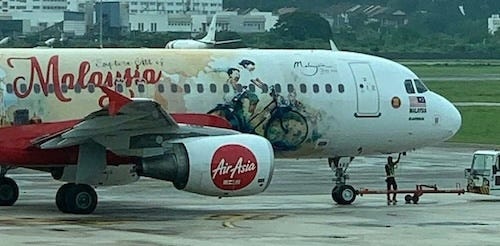
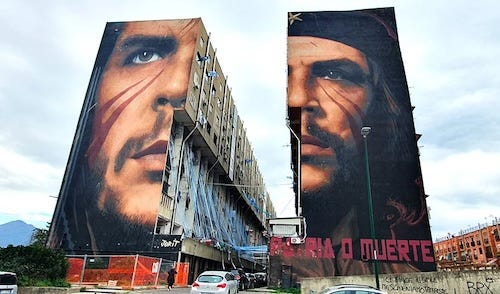
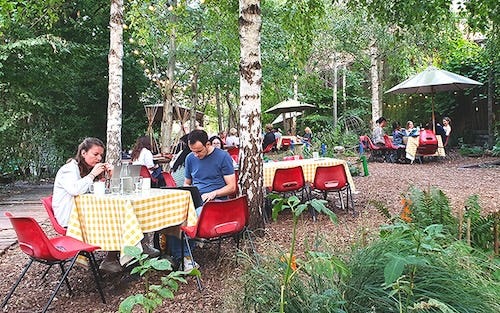
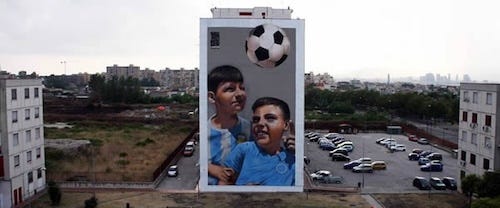
Effettivamente tema molto complesso. Mi sembra anche che alcune cose si possano ricollegare ad una tua precedente nl in cui parlavi del concetto di Disneyfication - Se la street art per propria natura nasce per denunciare e combattere, ma poi succedono queste cose, rischiamo praticamente di avere a che fare solo con arte nata per abbellimento.
A volte penso che in questi casi la soluzione migliore sia quella di andare a distruggere le proprie opere, rovinarle, coprirle e poi realizzarle nella stessa città, ma in zone totalmente diverse. In questo modo l'opera d'arte non è più un luogo di turismo di massa, perde il suo significato simbolico per la massa e quindi difficilmente nel marketing se ne approprieranno
Interessantissimo il tema del diritto d'autore, che inizia ad avere dei pregressi in ambito giuridico e quindi, sarà sempre più regolamentato. Spesso ci chiediamo anche se le opere di arte urbana che si vedono nei film (non semplicemente di passaggio, ma alcune scene sono proprio ambientate in modo che l'opera sia protagonista) sono state inserite previa richiesta all'autore... secondo noi no!